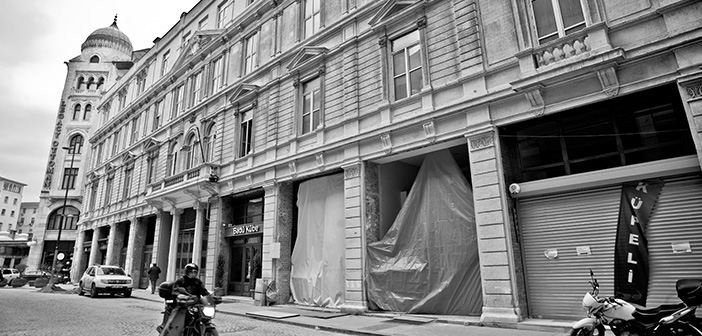Historic decision on Sanasaryan Han


The Court of Cassation (CoC) has issued a historic decision with regard to Sanasaryan Han, built for the education of Armenian children and seized by the State, which did not allow it to be used. CoC ruled for the admissibility of the lawsuit, filed for the return of the title deed thereof. On the other hand, CoC described the previous title deed transactions with regard to Sanasaryan Han as ‘unlawful entries /irregular registrations’. With this case, the legal personality of the Patriarchate of the Armenians of Turkey has been recognised for the first time. The title deed of Sanasaryan Han is expected to pass over to the Patriarchate of the Armenians of Turkey in the next couple of years.
Being one of the historic hans (inn) of Istanbul, Sanasaryan Han is one of the most outstanding seized properties of the Armenian community in Turkey. The han had been donated to the Patriarchate of the Armenians of Turkey in order to be used in the education of Armenian children, who might have difficulties to get education. However, after a short while, it was confiscated by the State.
The Patriarchate of the Armenians of Turkey launched a legal action four years ago on Sanasaryan Han. In 2014, a lawsuit was filed with Istanbul 13th Civil Court of First Instance for the cancellation of the transaction, which resulted in with the seizure of the property. On 3 July 2014 the Court, first, found the case admissible; yet later, rejected it on grounds that it was not within its jurisdiction. Following this, the Patriarchate approached the CoC. While the legal procedure was underway, the DG for Foundations launched a tender and leased out the Han without waiting for the verdict.
On 13 December 2017, CoC’s 1st Civil Chamber announced their reasoned decision. They overturned the ruling for the rejection of the case. The CoC ruling had important determinations therein, reading, “Considering that the first registration transactions, which were shaped up with administrative decisions, and those formed through court rulings where the complainant was not a party, would not be binding for the complaining foundation, both transactions need to be accepted a unlawful entries/irregular registrations,” and underlining that the actions leading up to the seizure of Sanasaryan Han were illegal.
Foundation recognised
Court of Cassation has provided an important assessment about Sanasaryan Foundation. It has drawn attention to the legal entity of the Foundation and that it was a Religious Community Foundation. Hence the Foundation has been revived once again.
The following statements were included in the decision: "It is clearly noted that the immovable property that is subject to dispute had been registered in the name of Sanasaryan Foundation on 24 May 1929, the founder was Ağa Muğradiç Sanasaryan from the Armenian community, in its Charter it was noted that the immovable properties of the foundation were to be used in view of providing for the education and training needs of poor children of the Armenian community, therefore holds the status of a Religious Community foundation."
Legal personality to the Patriarchate
In 2008 new amendments were introduced to the Foundations Law for non-Muslim foundations. CoC has underlined that the amendment has extended new rights to community foundation.
Along with the aforesaid CoC decision, Patriarchate of the Armenians of Turkey has acquired legal personality upon litigation of the case and its recognition as a party of the court case.
CoC has quashed the decision of 13th Civil Court of First Instance of İstanbul for rejecting the case, and ruled for retrial. Local court is expected to decide in line with the CoC's ruling.
Sanasaryan Han case is quite significant. Ali Elbeyoğlu, the attorney of the case, analysed the CoC judgment to Agos.
Following the CoC judgment, Elbeyoğlu said the case will be returned to the local court and the title-deed may be obtained upon the conclusion of the relevant process. Elbeyoğlu noted that this process may take 1,5 or 2,5 years depending on the speed of the trial.
Drawing attention to the extremely important achievements marked on numerous issues with the CoC judgment, Elbeyoğlu said:
"There are important aspects of this judgment. First of all, we have acquired the legal entity of the Armenia Patriarchate. We filed this case on behalf of the Patriarchate. [Normally] It should have been directly rejected on the grounds that those lacking a legal entity cannot become a party to the case. We launched the cases and they were accepted. They were only rejected due to lack of jurisdiction ratione loci. Thus the courts recognised the legal entity of the Patriarchate. However, there was need for a decision along the same lines from the CoC too. We were pending the judgment of the CoC. Legal entities may be formed through administrative means by enacting a law as well as through legal means. They did not enact a law but we have acquired a legal entity through legal means. The CoC could have rejected the case without looking into its substance and by saying, 'The Patriarchate does not have a legal entity, so it lacks competence' but that did not happen."


